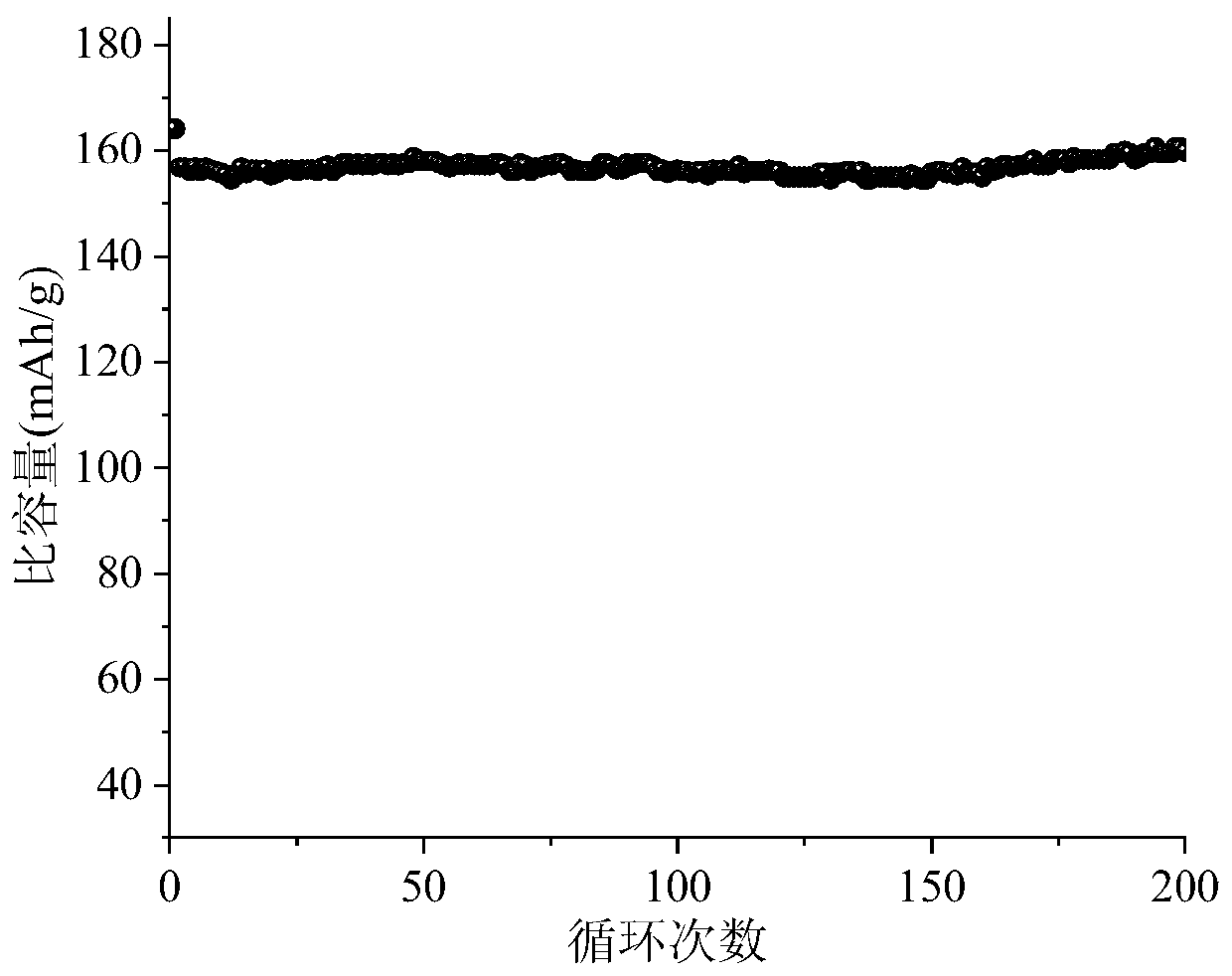Preparation method of lithium titanate negative electrode material of lithium ion battery
A lithium-ion battery and negative electrode material technology, applied in battery electrodes, secondary batteries, and secondary battery repair/maintenance, etc., can solve the problems of carbon material structure damage, capacity decay, thermal runaway, etc. Stable and highly conductive, structurally stable effect
- Summary
- Abstract
- Description
- Claims
- Application Information
AI Technical Summary
Problems solved by technology
Method used
Image
Examples
Embodiment 1
[0029] S1. Add 0.0045mol LiOH·H 2 O and 0.005mol Ti(OC 4 h 9 ) 4 respectively dissolved in 50mL of the first solvent, and then mixed uniformly under stirring conditions to obtain the first mixed solution, wherein the first solvent is a mixture of ethanol, ethylene glycol and glycerin, and the volume ratio of the three is 3:2 :1;
[0030] S2. Add 5mL of 20% hydrogen peroxide solution to the first mixed solution obtained in step S1, and stir vigorously for 30s, then transfer it to a 200mL reactor, then react at 180°C for 11h, collect the solid obtained in the reaction, and use After washing with anhydrous ethanol for 3 times, and calcining for 5 h under air atmosphere, the porous Li 4 Ti 5 o 12 Nanosheets;
[0031] S3. Dissolve 1g of medium-temperature coal tar pitch in 75mL of the second solvent, mix 2g of KOH and K 2 FeO 4 The mixture is dissolved in 75mL of the third solvent, and then the two are mixed to obtain the second mixed solution, wherein the second solvent i...
Embodiment 2
[0035] S1. Add 0.0045mol LiOH·H 2 O and 0.005mol Ti(OC 4 h 9 ) 4 respectively dissolved in 50mL of the first solvent, and then mixed uniformly under stirring conditions to obtain the first mixed solution, wherein the first solvent is a mixture of ethanol, ethylene glycol and glycerin, and the volume ratio of the three is 3:2 :1;
[0036] S2. Add 5mL of 20% hydrogen peroxide solution to the first mixed solution obtained in step S1, and stir vigorously for 30s, then transfer it to a 200mL reactor, then react at 160°C for 11h, collect the solid obtained in the reaction, and use After washing twice with absolute ethanol, calcined for 5 h under air atmosphere, the porous Li 4 Ti 5 o 12 Nanosheets;
[0037] S3. Dissolve 1g of medium-temperature coal tar pitch in 75mL of the second solvent, mix 2g of KOH and K 2 FeO 4 The mixture is dissolved in 75mL of the third solvent, and then the two are mixed to obtain the second mixed solution, wherein the second solvent is a mixture ...
Embodiment 3
[0041] S1. Add 0.0045mol LiOH·H 2 O and 0.005mol Ti(OC 4 h 9 ) 4 respectively dissolved in 50mL of the first solvent, and then mixed uniformly under stirring conditions to obtain the first mixed solution, wherein the first solvent is a mixture of ethanol, ethylene glycol and glycerin, and the volume ratio of the three is 3:2 :1;
[0042] S2. Add 5mL of 20% hydrogen peroxide solution to the first mixed solution obtained in step S1, stir vigorously for 30s, then transfer to a 200mL reaction kettle, then react at 200°C for 11h, collect the solid obtained from the reaction, and use After washing with anhydrous ethanol for 3 times, and calcining for 5 h under air atmosphere, the porous Li 4 Ti 5 o 12 Nanosheets;
[0043] S3. Dissolve 1g of medium-temperature coal tar pitch in 75mL of the second solvent, mix 2g of KOH and K 2 FeO 4 The mixture is dissolved in 75mL of the third solvent, and then the two are mixed to obtain the second mixed solution, wherein the second solven...
PUM
| Property | Measurement | Unit |
|---|---|---|
| density | aaaaa | aaaaa |
| density | aaaaa | aaaaa |
| porosity | aaaaa | aaaaa |
Abstract
Description
Claims
Application Information
 Login to View More
Login to View More - R&D
- Intellectual Property
- Life Sciences
- Materials
- Tech Scout
- Unparalleled Data Quality
- Higher Quality Content
- 60% Fewer Hallucinations
Browse by: Latest US Patents, China's latest patents, Technical Efficacy Thesaurus, Application Domain, Technology Topic, Popular Technical Reports.
© 2025 PatSnap. All rights reserved.Legal|Privacy policy|Modern Slavery Act Transparency Statement|Sitemap|About US| Contact US: help@patsnap.com



